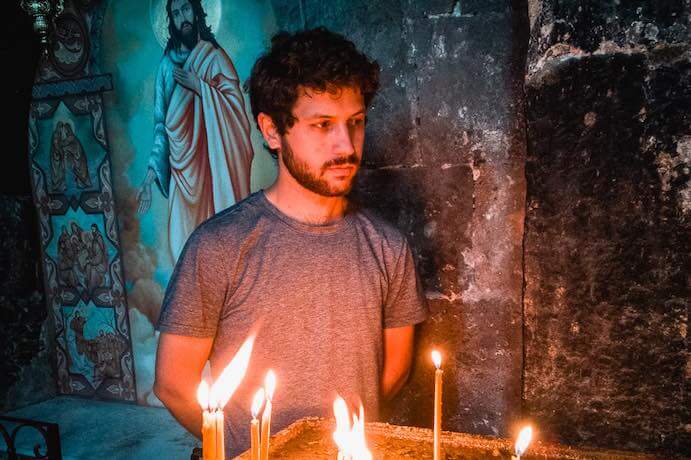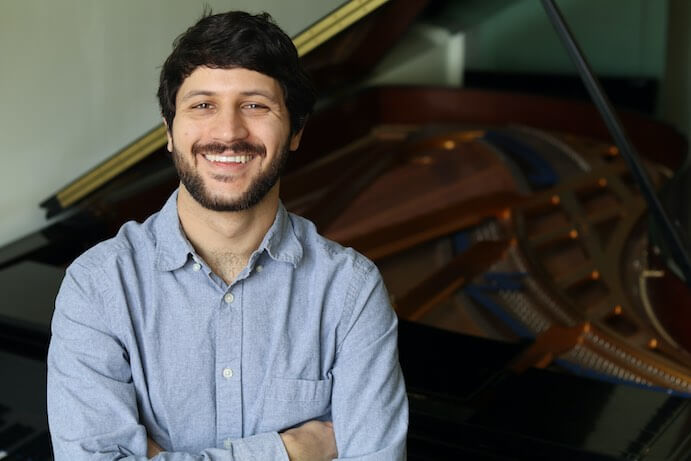Armenian-American composer and performer Joseph Bohigian often explores displacement, heritage, and identity as diaspora in his works. While normally based in California, Bohigian temporarily moved to his family’s ancestral homeland of Armenia to conduct research and “re-root” his work in the Armenian culture–one that is deeply marked by loss as a result of the Armenian Genocide (1915-1923) and Nagorno-Karabakh wars (1988-1994; 2020). Resulting from this period of relocation is Bohigian’s new work, The Water Has Found Its Crack (for three sopranos, violin, viola, cello, and percussion), a personal exploration of “identity boundaries and belonging in diaspora through music.” As an understanding member of Armenian diaspora and an immense admirer of Bohigian’s work, I jumped at the chance to ask some burning questions.
The Water Has Found Its Crack pulls its title from an essay by Turkish-Armenian editor Hrant Dink. What drew you to this text, and how does it translate to your creative approach for this piece?
In his essay, Dink writes about a French-Armenian woman who died while visiting the village of her youth in Turkey. When the question of where she should be buried arose, a man from the village responded, “Let her be buried here…the water has found its crack.” This story of Armenians’ longing to be reunited with their indigenous land, as Dink puts it, “to come and be buried under it,” was something I was thinking a lot about when I decided to move to Armenia to work on this project.
Dink also writes about the internalization of Armenians’ uprooting being passed down through generations. In this way, I viewed my composing of this piece as a process of re-rooting myself through music. It was a process of filtering Armenian music through my experience in diaspora in search of what Edward Said refers to as the contrapuntal nature of exilic awareness. My approach was to find a way in which, as a third-generation Armenian-American, my sense of Armenianness and Americanness exist not in opposition, but in counterpoint.
With Armenians having lost so much art to the genocide and Nagorno-Karabakh wars, how do you navigate the act of cultural preservation into your work with creating music that speaks to your present?
In The Water Has Found its Crack, this cultural preservation came partially through the text. When I was living in Yerevan, I worked at the Komitas Museum-Institute translating folk songs collected by the Armenian composer, musicologist, and priest Komitas Vardapet. I noticed that many of the songs referenced water as a metaphor for distance, longing, and loss, which fit nicely with the idea of the water finding its crack. For my piece, I took fragments of these lyrics and rearranged them to construct a new narrative. My goal was to capture the essence of the contemporary Armenian experience of dispersion rooted in our historical experience of exile, showing a continuity of Armenian identity formation through music across time.
There is also a section of the piece in which I wrote a quasi-folk song, one which recalls gestures of traditional folk music while also being something new. Like with the text, on a musical level I’m more interested in creating something new out of characteristics of the old, rather than quoting an existing folk song. This was not so much a conscious recontextualization of specific folk song material, but rather a way for the music to be representative of the sound world in which I had immersed myself in Armenia. It was only later that I discovered specific connections between musical gestures in my quasi-folk song and the traditional Armenian music I had been listening to.
I wrote another piece in Armenia called Khazeri Yerazhshtutyun (Music of Khazes) which deals explicitly with the dispossession of Armenian culture. The piece is a reinterpretation of the traditional Armenian system of musical notation which uses neumes called khaz. Much of the knowledge of the khaz system has been lost, so rather than trying to decipher the neumes’ original meanings, I treat them as gestural directions for the performer in a way that they can take on a new life as a form of graphic notation.

Joseph Bohigian performs with Ensemble Decipher–Photo by Alan Hankers
How do you communicate performance technique, interpretation, and context to your collaborators–especially to those who may perform or create outside Armenian folk tradition?
It was important to me to have a collaborative relationship with the singers from the beginning of writing The Water Has Found its Crack in order to effectively convey the types of music I’m referencing. I sent recordings of Armenian folk and sacred music to familiarize them with the sounds I had internalized, not only through my study in Armenia but also going back to the Armenian music I heard growing up in Fresno. We listened to sharakanner (hymns) I recorded at various churches in Yerevan, folk songs collected by Komitas, and kef music brought to the U.S. by Armenians from the Ottoman Empire in order to discuss the ways certain gestures in my piece reference these styles of singing. For example, there are these free, melismatic lines early on in the piece, which I thought of as a cross between a sped-up version of the sharakanner and ornamentations in migrant folk songs. With those recordings as a reference, I could describe my stylistic intentions in a way that went beyond the notation in the score.
Displacement and one’s relationship to “home” have come up often and in various forms in your music following your 2012 visit to Armenia. Why do you find yourself returning to these themes throughout the past several years?
Since that first visit to Armenia, I’ve been interested in asking not only, “Where is home?” but also, “What does home even mean?” for a people who have been continuously uprooted for over a century. I like journalist Liana Aghajanian’s answer to these questions in her Dining in Diaspora project, “Armenia may be a country, but it is also a concept, one that functions independent of geography.” It’s this reconstituted home divorced from place that really interests me. I’m searching for a reunion of multiple homes through music to mend the crack of displacement in the Armenian collective memory; to reconstitute Armenia not only as a physical place, but also as a spiritual one independent of geography.

Joseph Bohigian at Hovhannavank monastery in Armenia–Photo by Benjamin Dubuis
What are you hoping to communicate through this work, whether internally to yourself or externally to listeners?
Internally, this work is partly my attempt to situate myself within the realm of Armenian music. As I delved deeper into the relationship between my compositional work and Armenian culture, I found myself asking, “What is Armenian music? Is the music I’m writing ‘Armenian music?’” I didn’t necessarily come away with a clear answer to these questions, but to me it’s more important that I ask them than it is to succinctly answer them. The history of Armenian music is such that it has not only interacted with neighboring cultures, but it also interacts with music in the places around the world where Armenians have recreated “home.” In this way, I think the boundaries of Armenian music are quite fluid in a way that allows the music of Armenians in the diaspora to be just as Armenian as music created in Armenia.
Part of my interest in approaching Armenian issues in my work is that they are quite often overlooked because of their lack of political salience, but have universal resonances. I believe bridges can be built through sound, both interculturally and within a culture. Sometimes connections across cultures are expressed within a work, such as in my piece Hepimiz Hrant’ız on the reaction in Turkey to the 2007 assassination of Hrant Dink, where I sample protest chants in Turkish, Armenian, Kurdish, and English. Though The Water Has Found its Crack originates as an exploration of cultural reunification within the Armenian diaspora, I hope the piece will encourage listeners to make their own connections with this theme.
I CARE IF YOU LISTEN is an editorially-independent program of the American Composers Forum, funded with generous donor and institutional support. Opinions expressed are solely those of the author and may not represent the views of ICIYL or ACF.
A gift to ACF helps support the work of ICIYL. For more on ACF, visit the “At ACF” section or composersforum.org.




















